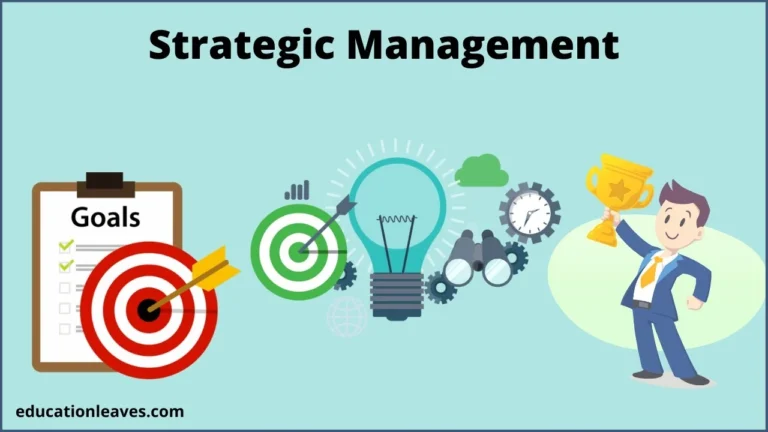

In the world of business, where change is constant and competition is fierce, having a well-thought-out strategy is the key to success. Strategic management is the art and science of formulating, implementing, and evaluating cross-functional decisions that enable an organization to achieve its objectives. In this article, we will delve into the significance of strategic management, its key components, and how it can elevate your business to new heights.
Understanding Strategic Management
Strategic management involves a systematic approach to defining an organization’s direction and making decisions on allocating its resources to pursue this direction. It is about aligning the organization’s internal strengths with external opportunities while addressing weaknesses and threats. At its core, it’s a structured way to answer fundamental questions like:
What is our mission and vision?
Every successful business begins with a clear mission and vision. These statements provide a sense of purpose and a long-term perspective for the organization.
Where do we stand in the market?
Understanding your position in the market, your strengths, and areas that need improvement is essential for devising effective strategies.
Where do we want to go?
Setting specific, measurable, achievable, relevant, and time-bound (SMART) goals helps in defining the desired future state of the organization.
How will we get there?
Developing strategies that outline the steps, actions, and resources required to achieve your goals is a crucial aspect of strategic management.
Key Components of Strategic Management
Strategic management is a dynamic and continuous process, comprising several interconnected components that collectively drive an organization toward success. Let’s delve deeper into these crucial elements:
Environmental Analysis:
At the core of strategic management is the need to comprehend the external environment thoroughly. This involves keeping a vigilant eye on market trends, staying attuned to the moves of competitors, adapting to regulatory changes, and seizing emerging opportunities. Understanding these external factors provides the foundation upon which strategic decisions are built.
SWOT Analysis:
Evaluating an organization’s internal landscape is equally vital. The SWOT analysis – an examination of Strengths, Weaknesses, Opportunities, and Threats – serves as a compass for informed decision-making. It unveils areas that require improvement and illuminates potential growth avenues. This introspective process empowers organizations to capitalize on their strengths, shore up their weaknesses, exploit opportunities, and mitigate threats effectively.
Strategy Formulation:
With a clear grasp of the internal and external dynamics, it’s time to formulate a strategy. This critical phase involves setting specific objectives and charting the optimal course of action to achieve them. It’s where the organization defines its mission, vision, and long-term goals, aligning its efforts toward a unified purpose.
Strategy Implementation:
Formulating a strategy is just the beginning; real success lies in effective implementation. This phase is where theory meets practice, and it requires careful resource allocation, precise communication, and strong leadership. It’s about ensuring that everyone in the organization understands their role in executing the strategy and works collectively toward its realization.
Strategy Evaluation:
The strategic journey doesn’t end with implementation; it’s an ongoing process. Regularly assessing the progress and effectiveness of the strategy is essential. This evaluation helps in understanding whether the organization is on track to achieve its goals and whether adjustments are needed. It’s a vital feedback loop that allows for agility and adaptability in an ever-evolving business landscape.
Benefits of Effective Strategic Management
Strategic management isn’t just a theoretical exercise; it yields tangible benefits for businesses of all sizes. Here are some of the advantages:
Improved Decision-Making
Strategic management provides a structured framework for decision-making, reducing the reliance on intuition and guesswork.
Competitive Advantage
Businesses with well-defined strategies are better equipped to outperform their competitors and adapt to market changes.
Resource Allocation
It ensures that resources such as finances, human capital, and time are allocated efficiently to support the organization’s objectives.
Adaptability
A robust strategic management process enables organizations to adapt to changing market conditions and seize new opportunities.
Long-Term Sustainability
By focusing on long-term goals and sustainable practices, strategic management helps businesses thrive over time.
Strategic management is the compass that guides a business toward success in today’s dynamic and competitive landscape. It’s a comprehensive process that involves analyzing, planning, executing, and evaluating strategies to achieve long-term objectives. Embracing strategic management can set your business on a path to sustained growth and prosperity. So, don’t just aimlessly navigate the business world – strategize your way to success.
The CXO Time Magazine is one of the leading global platforms for leaders and entrepreneurs to showcase their stories.








About Us
The CXO Time Magazine is one of the leading global platforms for leaders and entrepreneurs to showcase their stories.
Reach us: info@thecxotime.com